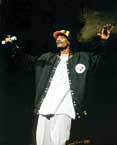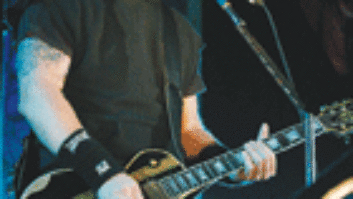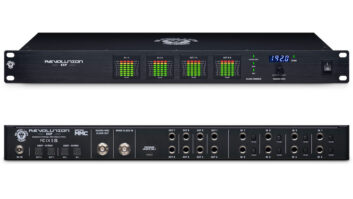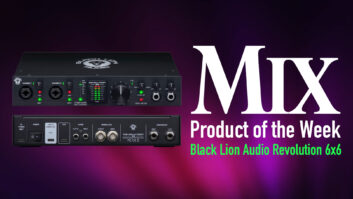
Snoop Dogg and his pimped-out mic
On a Saturday evening in mid-August, a quick stroll through the sprawling, grassy parking lot of Charlotte, N.C.’s Verizon Wireless Amphitheater revealed something about Projekt Revolution. Unlike what’s heard in the majority of concert parking lots, the music that blasted from countless car stereos wasn’t all the same. It was a wash of guttural metallic grinds, the blips and bubbles of hip hop and all-American backbeats.

Linkin Park vocalist Chester Bennington
Co-headliners Linkin Park, Korn and Snoop Dogg, along with The Used and Less Than Jake, Projekt Revolution’s diverse bill is “annihilating the boundaries of genres,” to quote Linkin Park guitarist Brad Delson. “Projekt Revolution isn’t simply a tour,” he continues, “it’s a state of mind.”
SET IT AND FORGET IT
According to Showco’s Jason Vrobel — Projekt Revolution’s systems engineer and crew chief — choosing the company’s Prism Series P.A. array system lets him give each band their exact sound. “The system is columns of Prisms, 16 subs per side, and it’s all controlled through the Clair Bros. I/O,” Vrobel explains. “For me, it’s about adjusting the EQ and changing the levels they’re sending out, which changes from band to band. Some of the bands like lots of low end and some don’t like it whatsoever.”

Korn FOH engineer Bill Sheppell
For Korn’s front-of-house engineer Bill Sheppell, the Prism P.A. works incredibly well. “If the gain structure is set right, I can keep everything in check gain-wise and make it loud but comfortable and not harsh,” he reasons. “The band asks me every night, ‘Hey, did you crush ’em?’ They want to know that it was a big rock show.”

Dave Aron, Snoop Dogg FOH engineer
Snoop Dogg’s FOH engineer, Dave Aron, credits the tour’s smooth-sailing to Vrobel. “Vrobel’s a great tech,” he attests. “It makes touring fun when someone is really willing to go out and get the sound that you’re looking for and make the necessary adjustments.”
System tuning, while relatively consistent from venue to venue, isn’t taken to extremes. Says Linkin Park FOH engineer Brad Divens, “The Prism is a very consistent rig. At the beginning of the day, I’ll listen to a few tracks of my CD and a [Shure] SM58 through the P.A. with some pink noise. Bill then has a CD he’ll listen to. After a few little tweaks on the I/O, we’re ready to go. You know that there are a few spots you’ll hit once the house fills up and it gets a little cooler, but I don’t tend to over-EQ the P.A. I’d rather have to take something out later than to put something back.”
Most everyone on the tour shares this “less-is-more” approach when it comes to system equalization. “The one thing I’ve learned over the years is that on the days when the place sounds really bad, we don’t bury ourselves in unnecessary work,” Korn monitor engineer Scott Tatter says. “We’re not going to kill ourselves all morning trying to fix a tiny nuance because we know that it’s not going to make things sound okay. We know that our source signal is good, and we’re not going to over-EQ.”
ONE SHOWCONSOLE, FIVE ACTS
From square one, those selecting the equipment made sure that all engineers would be comfortable with each piece of gear, and that they were equipped to deliver the sound that the audience expects and the bands demand. Each FOH engineer is using Showco’s Showconsole. “It saves a lot of space,” says Vrobel about the digital desk. “In an amphitheater, you don’t have a lot of room at front of house and you really can’t carry four different consoles. It also saves a lot of time and patching.”
Luckily, the desk has effectively found approval from everyone. “This is probably the sixth tour I’ve used it on and I just love the way it sounds,” Divens comments. “It makes changes painless at front of house, and because there’s only one desk, everyone is on a level playing field. It’s like, ‘This is my P.A. and now it’s yours.’ I think that makes it more enjoyable for everyone.”
Sheppell, who has used the Showconsole since its introduction, agrees that it’s a good choice for the tour. “After using a D5 on Ozzfest, we chose to use [the Showconsole] for a bunch of international dates because it’s a lot lighter and doesn’t have a big execution rack,” he says. “The Showconsole does sound really, really good.”
MONITORING MINUTIAE
While the concept of a shared Showconsole worked well at FOH, the tour’s monitoring engineers brought in other choices: Linkin Park brought in a Midas Heritage 3000, while the other acts chose a DiGiCo D5 Live.

Brad Wright, monitor engineer for Linkin Park
“It’s all smoothed out now,” says Linkin Park monitor engineer Brad Wright. “I ended up swapping consoles and I chose the Heritage. I really like it a lot, especially when dealing with so many in-ear mixes.”
Linkin Park — a six-piece band that includes vocalist Chester Bennington, vocalist Mike Shinoda, guitarist Delson, turntablist Joseph Hahn, drummer Rob Bourdon and bassist Phoenix — is almost completely on IEMs with the exception of Phoenix and Delson, who use Prism wedges and sidefills for monitoring. For Wright, that — combined with the band’s thick instrumentation — makes for involved monitor mixes. “I enjoy mixing Chester because he basically wants a full, FOH-style mix. Everyone else also wants a full mix, except for Rob, who doesn’t take drums, which is kind of strange: just the kick to a Buttkicker on his throne.”
For all IEM needs, Linkin Park uses Ultimate Ears UE7, while Delson prefers extreme monitoring isolation. “He wears -25dB foam inserts and shotgun muffs on top of that,” Wright says with a chuckle. “If I put those things on and walk around, all I can hear is my heartbeat and my feet!”

Korn monitor engineer Scott Tatter
For Korn and the rest of the acts, using the DiGiCo D5 has worked well. “I love it,” states Tatter. “I’d like to never have to mix on another console. It just does everything that I need it to do.”
Korn (vocalist Jonathan Davis, bassist Fieldy, drummer David Silveria, and guitarists James “Munky” Shaffer and Brian “Head” Welch) uses all wedges for monitoring, except for Silveria, who uses a Shure PSM600 personal ear monitoring system. “Everybody wants to hear everybody else,” Tatter explains. “Munky and Head need to hear each other. Munky starts every song, Head needs to hear him, and it’s freaking loud over there, so I’m riding my intros a lot. Jonathan has a big, fat stereo band mix up there, which is also what’s in the side-fills. David’s on in-ears, but it’s a quiet, high-end attack-y mix. Along with that, he has six 18s, four 14s and two thumpers for drum fill. The wedges don’t go over 200 Hz, I boost 80 Hz in the subs and use a Behringer Subharmonizer to get a little more low going. So there’s tons of air moving up there, but all the magic is in the in-ears.”
MIXING DOGGY-STYLE
Snoop Dogg doesn’t travel with his own monitoring engineer, but Showco monitor systems tech Seth Kendall expertly handles his needs on the D5. Kendall delivers mostly full wedge mixes for The Snoopadelics, the rapper’s freewheeling backing band. “We hired great jazz guys,” explains Snoop Dogg’s FOH engineer Aron. Aron has worked with Snoop as a studio and live engineer since 1992. “These guys are used to really stretching out and just get the blend as far as mixing is concerned. The band just has to roll with what Snoop’s doing, and so do I and the rest of the crew.”
According to Aron, the continual shift between the studio and the road allows him to intuitively know what Snoop needs. “Snoop, [backup rappers] Daz Dillinger and Superfly have it together, but everyone takes their own approach. We used to do all the shows without the band, but for this tour, we felt like there were a few elements missing from the tracks, and we’ve got both the DJ and the band going at the same time. Sometimes, I have to filter out a bit of the low end on the tracks and let the band fill it in.”
Snoop’s raps are delivered via a “pimped-out” Sennheiser Evolution wireless mic. “It’s all rhinestones and platinum, engraved and has a handle,” Aron enthusiastically explains. “It sounds and looks great. For the mix, Snoop’s always out front, and it’s important that the vocal is crystal-clear. I don’t use any reverb on his voice, and I leave it dry for most of the show, just throwing in delays here and there. It’s spontaneous.”

Korn’s vocalist Jonathan Davis
ROCKIN’ OUT TO KORN
At FOH for Korn, Sheppell is a seasoned pro at delivering Korn’s highly identifiable, venue-rattling metal, which he claims is surprisingly uncomplicated. Using an all-Shure microphone setup, guitars are miked via road iso cabinets. More than 30 inputs are used for drums, and all bass guitar sounds are direct. For vocals, Davis uses what Sheppell refers to as a “truly hybrid” microphone: a Shure U24D/Beta 58A. “Mike Allison, a Showco systems engineer now touring with Van Halen, built it,” Sheppell says. “Jonathan refuses to use a round windscreen — he hits his teeth on it — so we have a Beta 56 screen and a hot-rodded capsule inside.”
Davis’ vocal signal continues to a Summit TLA-100 leveling amplifier and a Shure DFR22 audio processor with a feedback filter. Sheppell claims that the vocalist isn’t a very loud singer, so finding ways to increase signal output is a must. “After Linkin Park does their line-check, we’ll take the mic down-stage and run it as high as we can,” Sheppell explains. “If we feel that there will be some feedback problems, I’ll kick in the BSS Audio DFR-22 and notch a few things out. Other than that, it’s just about keeping my hands on the faders.”
For effects, Sheppell rolls in his own rack loaded with processors he has programmed during his years of working with Korn. “I hated having a rack shipped out for every leg and then having to re-program the whole show again and again. I have a different scene for every song, and it all works really well.”

Linkin Park FOH engineer Brad Divins
IN THE END, AUDIO MATTERS
Onstage, Linkin Park uses all Audio-Technica microphones except for a few stray Shure SM57s and a Shure Beta 91/Audio-Technica 2500 combination on the kick. An Audio-Technica 3300 wireless condenser is used on vocalists Bennington and co-lead/rapper Mike Shinoda. According to Divens, “For Chester, we go through the console’s mic preamp to a BSS 901 and then into a Manley ELOP pre-EQ. I’m also engaging the limiter on the channel strip just a tiny bit when he eats the mic. For Mike, I run him straight into the Manley.”
Mixing dual lead voices means lots of continual adjustments for Divens. “I try to put Chester front and center in the mix, but it’s give-and-take with him and Mike throughout the night. I have fingers on those two VCAs all night long.” Although Divens uses a small chamber reverb and a micro-pitch shift program via an Eventide H3000, vocal effects are kept to a minimum.
Guitar tones are gathered with a Shure SM57 and Audio-Technica 4050 on each cabinet, while the bass guitar uses a SansAmp RBI unit and a PSA1: one pre, one post. Add DJ Joe Hahn to the mix, and the aural landscape is thick but well-defined. “I like to keep the overall sound really true to the records,” Divens explains. “There is the nice, thick guitar, the Pro Tools tracks are always going, and there’s a fine line in-between where the vocals, the turntables and the electronics are. I spread the guitars out and create that hole for the vocals and electronics.”
Since the fall of 2000, Divens has witnessed Linkin Park’s continual musical growth from the best seat in the house. “It started as a bus and a trailer and now it’s grown to 16 trucks and eight buses,” Divens reminisces. “My challenges are few. If I’m able to make those 15,000 to 20,000 people at each show happy, then it’s going to be a great show and I’ve done my job.”






